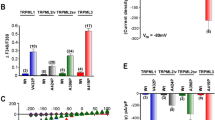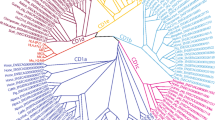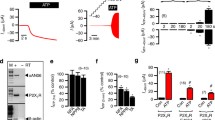Abstract
The TRPML2 protein, encoded by the Mcoln2 gene, is one of the three mucolipins (TRPML1–3), a subset of the TRP superfamily of ion channels. Although there are no thorough studies on the cellular distribution of TRPML2, its mRNA appears to be largely restricted to lymphocytes and other immune cells. This contrasts with the ubiquitous expression of TRPML1 and the limited but diverse expression of TRPML3 and clearly suggests a specialized role for TRPML2 in immunity. Localization studies indicate that TRPML2 is present in lysosomes (including the specialized lysosome-related organelle that B-lymphocytes use for processing of the antigen-bound B-cell receptor), late endosomes, recycling endosomes, and, at a much lower level, the plasma membrane. Heterologously expressed TRPML2, like TRPML1 and/or TRPML3, forms ion channels that can be activated by a gain-of-function mutation (alanine to proline in the fifth transmembrane domain, close to the pore) that favors the open state, by a transient reduction of extracellular sodium followed by sodium replenishment, by small chemicals related to sulfonamides, and by PI(3,5)P2, a rare phosphoinositide that naturally accumulates in the membranes of endosomes and lysosomes and thus could act as a physiologically relevant agonist. TRPML2 channels are inwardly rectifying and permeable to Ca2+, Na+, and Fe2+. When heterologously co-expressed, TRPML2 can form heteromultimers with TRPML1 and TRPML3. In B-lymphocytes, TRPML2 and TRPML1 may play redundant roles in the function of their specialized lysosome. Although the specific subcellular function of TRPML2 is unknown, distribution and channel properties suggest roles in calcium release from endolysosomes, perhaps to regulate vesicle fusion and/or subsequent scission or to release calcium from intracellular acidic stores for signaling in the cytosol. Alternatively, TRPML2 could function in the plasma membrane, and its abundance in vesicles of the endocytic pathway could simply be due to regulation by endocytosis and exocytosis. The Mcoln2 gene is closely downstream from and in the same orientation as Mcoln3 in the genomes of most jawed vertebrates (from humans to sharks) with the exception of pigs, Xenopus tropicalis, and ray-finned fishes. The close homology of TRPML2 and 3 (closer to each other than to TRPML1) suggests that Mcoln2 and Mcoln3 arose from unequal crossing over that duplicated a common ancestor and placed both gene copies in tandem. These genes would have come apart subsequently in pigs, Xenopus, and the ancestor to ray-finned fishes. All jawed vertebrates for which we have thorough genomic knowledge have distinct Mcoln1, 2, and 3 genes (except ray-finned fishes which, probably due to the whole-genome duplication in their common ancestor, have two Mcoln1-like genes and two Mcoln3-like genes, although only one Mcoln2 gene). However, the available genomes of invertebrate deuterostomes (a sea urchin, lancelet, and two tunicates) contain a single mucolipin gene that is equally distant from the three vertebrate mucolipins. Hence, vertebrate mucolipins arose through two rounds of gene duplication (the first one likely producing Mcoln1 and the ancestor to Mcoln2 and 3) at some time between the onset of craniates and that of jawed vertebrates. This is also the evolutionary period during which adaptive immunity appeared. Given the restricted expression of TRPML2 in immune cells, this evolutionary history suggests a functional role in the adaptive immunity characteristic of vertebrates.
Access this chapter
Tax calculation will be finalised at checkout
Purchases are for personal use only
Similar content being viewed by others
References
Castiglioni AJ, Remis NN, Flores EN, García-Añoveros J (2011) Expression and vesicular localization of mouse Trpml3 in stria vascularis, hair cells, and vomeronasal and olfactory receptor neurons. J Comp Neurol 519:1095–1114
Cheng X, Shen D, Samie M, Xu H (2010) Mucolipins: intracellular TRPML1-3 channels. FEBS Lett 584(10):2013–2021
Curcio-Morelli C, Zhang P, Venugopal B, Charles FA, Browning MF, Cantiello HF, Slaugenhaupt SA (2010) Functional multimerization of mucolipin channel proteins. J Cell Physiol 222:328–335
Dong XP, Cheng X, Mills E, Delling M, Wang F, Kurz T, Xu H (2008) The type IV mucolipidosis-associated protein TRPML1 is an endolysosomal iron release channel. Nature 455:992–996
Dong XP, Shen D, Wang X, Dawson T, Li X, Zhang Q, Cheng X, Zhang Y, Weisman LS, Delling M, Xu H (2010) PI(3,5)P(2) controls membrane trafficking by direct activation of mucolipin Ca(2+) release channels in the endolysosome. Nat Commun 1:38
Flajnik MF, Kasahara M (2010) Origin and evolution of the adaptive immune system: genetic events and selective pressures. Nat Rev Genet 11:47–59
Flores EN, García-Añoveros J (2011) TRPML2 and the evolution of mucolipins. Adv Exp Med Biol 704:221–228
Grimm C, Cuajungco MP, van Aken AF, Schnee M, Jors S, Kros CJ, Ricci AJ, Heller S (2007) A helix-breaking mutation in TRPML3 leads to constitutive activity underlying deafness in the varitint-waddler mouse. Proc Natl Acad Sci USA 104:19583–19588
Grimm C, Jors S, Saldanha SA, Obukhov AG, Pan B, Oshima K, Cuajungco MP, Chase P, Hodder P, Heller S (2010) Small molecule activators of TRPML3. Chem Biol 17:135–148
Grimm C, Jors S, Guo Z, Obukhov AG, Heller S (2012) Constitutive activity of TRPML2 and TRPML3 channels versus activation by low extracellular sodium and small molecules. J Biol Chem 287:22701–22708
Karacsonyi C, Miguel AS, Puertollano R (2007) Mucolipin-2 localizes to the Arf6-associated pathway and regulates recycling of GPI-APs. Traffic 8:1404–1414
Kim HJ, Li Q, Tjon-Kon-Sang S, So I, Kiselyov K, Muallem S (2007) Gain-of-function mutation in TRPML3 causes the mouse Varitint-Waddler phenotype. J Biol Chem 282:36138–36142
Lev S, Zeevi DA, Frumkin A, Offen-Glasner V, Bach G, Minke B (2010) Constitutive activity of the human TRPML2 channel induces cell degeneration. J Biol Chem 285:2771–2782
Lindvall JM, Blomberg KE, Wennborg A, Smith CI (2005) Differential expression and molecular characterisation of Lmo7, Myo1e, Sash1, and Mcoln2 genes in Btk-defective B-cells. Cell Immunol 235:46–55
Nagata K, Zheng L, Madathany T, Castiglioni AJ, Bartles JR, García-Añoveros J (2008) The varitint-waddler (Va) deafness mutation in TRPML3 generates constitutive, inward rectifying currents and causes cell degeneration. Proc Natl Acad Sci USA 105:353–358
Puertollano R, Kiselyov K (2009) TRPMLs: in sickness and in health. Am J Physiol Renal Physiol 296:F1245–F1254
Samie MA, Grimm C, Evans JA, Curcio-Morelli C, Heller S, Slaugenhaupt SA, Cuajungco MP (2009) The tissue-specific expression of TRPML2 (MCOLN-2) gene is influenced by the presence of TRPML1. Pflugers Arch 459:79–91
Song Y, Dayalu R, Matthews SA, Scharenberg AM (2006) TRPML cation channels regulate the specialized lysosomal compartment of vertebrate B-lymphocytes. Eur J Cell Biol 85:1253–1264
Venkatachalam K, Hofmann T, Montell C (2006) Lysosomal localization of TRPML3 depends on TRPML2 and the mucolipidosis-associated protein TRPML1. J Biol Chem 281:17517–17527
Venkatesh B, Ravi V, Lee AP, Warren WC, Brenner S (2013) Basal vertebrates clarify the evolutionary history of ciliopathy-associated genes Tmem138 and Tmem216. Mol Biol Evol 30:62–65
Venugopal B, Mesires NT, Kennedy JC, Curcio-Morelli C, Laplante JM, Dice JF, Slaugenhaupt SA (2009) Chaperone-mediated autophagy is defective in mucolipidosis type IV. J Cell Physiol 219:344–353
Xu H, Delling M, Li L, Dong X, Clapham DE (2007) Activating mutation in a mucolipin transient receptor potential channel leads to melanocyte loss in varitint-waddler mice. Proc Natl Acad Sci USA 104:18321–18326
Zeevi DA, Frumkin A, Offen-Glasner V, Kogot-Levin A, Bach G (2009) A potentially dynamic lysosomal role for the endogenous TRPML proteins. J Pathol 219:153–162
Zeevi DA, Lev S, Frumkin A, Minke B, Bach G (2010) Heteromultimeric TRPML channel assemblies play a crucial role in the regulation of cell viability models and starvation-induced autophagy. J Cell Sci 123:3112–3124
Acknowledgment
Authors of this manuscript were funded by by R01 NS44363 from NIH-NINDS (to JG-A)
Author information
Authors and Affiliations
Corresponding author
Editor information
Editors and Affiliations
Rights and permissions
Copyright information
© 2014 Springer-Verlag Berlin Heidelberg
About this chapter
Cite this chapter
García-Añoveros, J., Wiwatpanit, T. (2014). TRPML2 and Mucolipin Evolution. In: Nilius, B., Flockerzi, V. (eds) Mammalian Transient Receptor Potential (TRP) Cation Channels. Handbook of Experimental Pharmacology, vol 222. Springer, Berlin, Heidelberg. https://doi.org/10.1007/978-3-642-54215-2_25
Download citation
DOI: https://doi.org/10.1007/978-3-642-54215-2_25
Published:
Publisher Name: Springer, Berlin, Heidelberg
Print ISBN: 978-3-642-54214-5
Online ISBN: 978-3-642-54215-2
eBook Packages: Biomedical and Life SciencesBiomedical and Life Sciences (R0)




